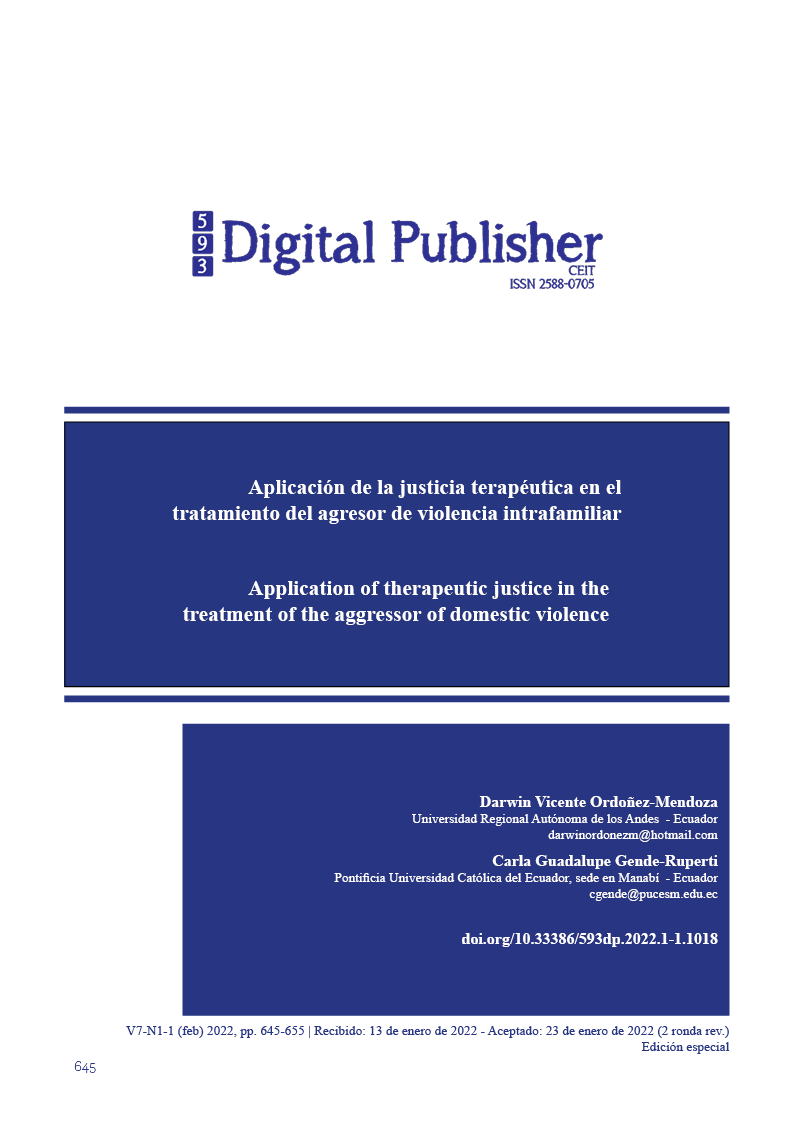Application of therapeutic justice in the treatment of the aggressor of domestic violence
Main Article Content
Abstract
Undoubtedly, disputes in criminal courts arise in cases of domestic violence where the conciliation judge will continue to be responsible for the future result, in addition to the need to intervene immediately to determine the resources, not only in the family sphere, but also in the social activities of those involved, and even in the formation of a new family. Judicial mediation is not effective because it separates the couple, but the criminal judge must avoid the behavior of the aggressor in the family with another couple and therefore with a different family group.
Downloads
Article Details

This work is licensed under a Creative Commons Attribution-NonCommercial-ShareAlike 4.0 International License.
1. Derechos de autor
Las obras que se publican en 593 Digital Publisher CEIT están sujetas a los siguientes términos:
1.1. 593 Digital Publisher CEIT, conserva los derechos patrimoniales (copyright) de las obras publicadas, favorece y permite la reutilización de las mismas bajo la licencia Licencia Creative Commons 4.0 de Reconocimiento-NoComercial-CompartirIgual 4.0, por lo cual se pueden copiar, usar, difundir, transmitir y exponer públicamente, siempre que:
1.1.a. Se cite la autoría y fuente original de su publicación (revista, editorial, URL).
1.1.b. No se usen para fines comerciales u onerosos.
1.1.c. Se mencione la existencia y especificaciones de esta licencia de uso.
References
Arroyo, L. (2014). El derecho desde otra concepción. Bogotá: San Andrés.
Asamblea Nacional. (2018). Ley Orgánica Integral para Prevenir y Erradicar la Violencia contra las Mujeres . Quito: Ley 0. Registro Oficial Suplemento 175 de 05-feb.-2018.
Buenaga, Ó. (2017). El derecho a la Seguridad Social . Granada: Editorial Comares .
Código Integral Penal. (2014).
Duque, R. (2019). Proceso, tutela judicial y estado social de derecho . Madrid: Rete Iuris .
García, A. (2018). Realidad Jurídica y Penal de Suramérica. Bogotá: Temis.
Goyeneche, S. (2013). Violencia Intrafamiliar. Brasilia: Optocus.
INEC. (2019). Encuesta Nacional sobre Relaciones Familiares y Violencia de Género contra las Mujeres. Quito : INEC, Recuperado de: https://www.ecuadorencifras.gob.ec/documentos/web-inec/Estadisticas_Sociales/Violencia_de_genero_2019/Principales%20resultados%20ENVIGMU%202019.pdf.
Lagarde, E. (2016). Contexto de una cultura patriarcal androcéntrica. Buenos Aires: Linesia.
Mosquera, V. (2018). La violencia fisica. Madrid: Librimundi.
ONU. (1995). Declaracion de los derechos de la mujer.
Sarno, L. (2017). Violencia doméstica contra la mujer: Concepciones y respuestas en América Latina. Buenos Aires: Oligarso.
UNICEF. (2019). Dossier informativo sobre la campaña #AhoraQueLoVes #DiNoMás. Quito: El Fondo de las Naciones Unidas para la Infancia – UNICEF.
Velasco, R. (2018). La duración del proceso en los delitos de violencia física contra la mujer dentro del núcleo familiar afecta el principio de igualdad y no discriminación. Medellín: Santander.
Zambrano, A. (2015). Proceso penal y garantías constitucionales. Corporación de Estudios y Publicaciones., 35.



